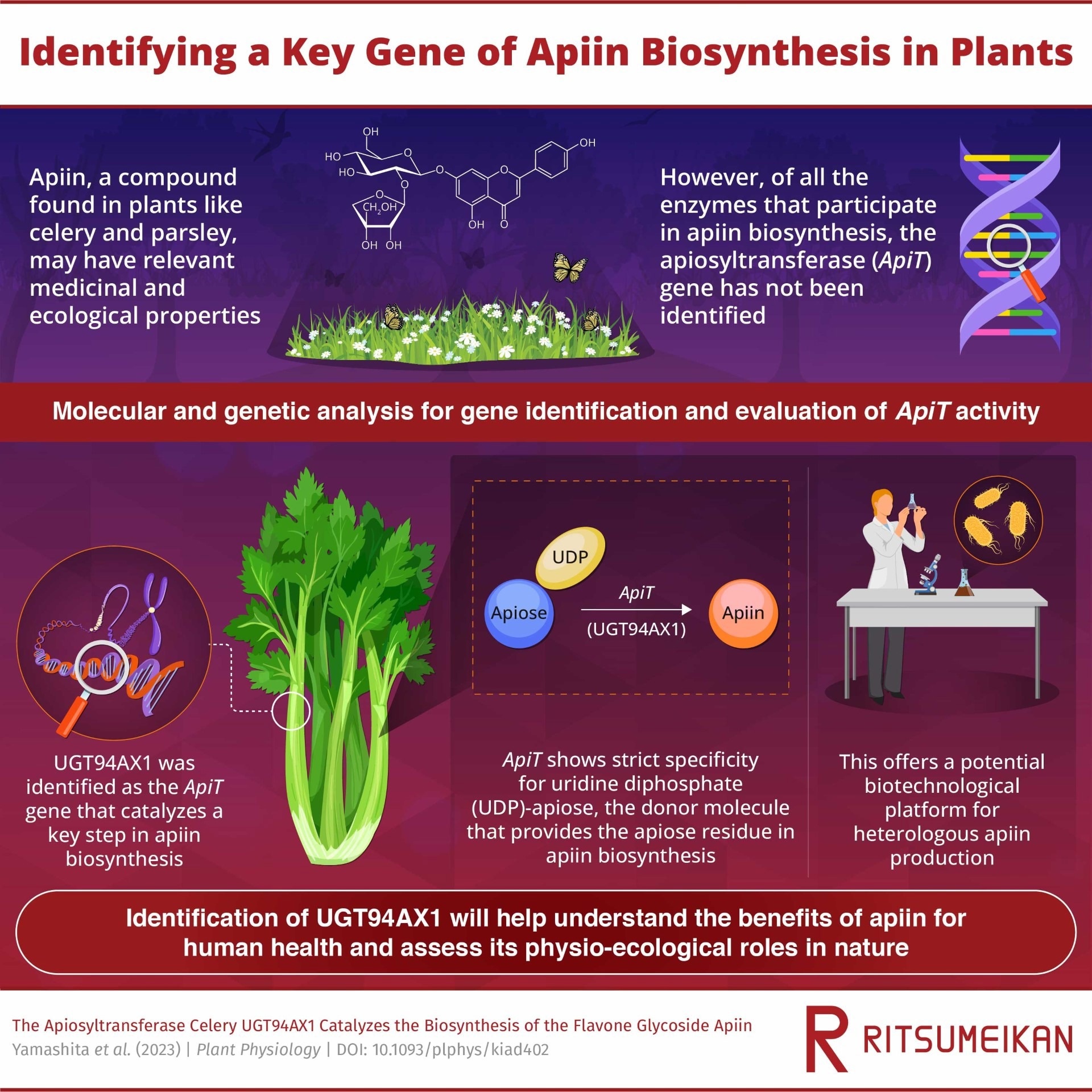Apiin, a natural compound found in high amounts in parsley and celery, is thought to have important medicinal properties. However, producing apiin is difficult because the gene that codes for apiosyltransferase, an important enzyme in apiin synthesis, was unknown. In a recent study, scientists from Japan successfully identified this gene in celery. Their findings will pave the way to biosynthesis platforms to produce apiin, which in turn will help us clarify its natural role and medical applications.
 Apiin is naturally produced by many plants and is believed to have medicinal applications. Now, scientists have finally identified the gene that codes for apiosyltransferase, the enzyme that performs the final modification step during apiin synthesis. These findings will enable us to develop platforms to produce large amounts of apiin, which in turn will help us clarify its properties and natural functions. Image Credit: Takeshi Ishimizu from Ritsumeikan University
Apiin is naturally produced by many plants and is believed to have medicinal applications. Now, scientists have finally identified the gene that codes for apiosyltransferase, the enzyme that performs the final modification step during apiin synthesis. These findings will enable us to develop platforms to produce large amounts of apiin, which in turn will help us clarify its properties and natural functions. Image Credit: Takeshi Ishimizu from Ritsumeikan University
The herbs celery and parsley are widely used for medicinal and health purposes by humans due to their numerous health benefits. The medicinal uses of these plants date back to the ancient Greeks, Egyptians, and Romans. Although scientists have not yet identified their main active compounds, some believe "apiin" may be one of them. There is some evidence that apiin, classified as a flavonoid glycoside, has proven anticancer and anxiolytic properties in humans. Additionally, celery and parsley produce this compound in large amounts as compared to other plants. Biologists have hypothesized that apiin offers antioxidant, anti-UV light, and insect repellent effects, thus serving essential biological and ecological roles.
However, to prove any of these claims with certainty, we need to find a way to produce apiin in large amounts. While scientists have identified the genes of almost all the enzymes that partake in apiin synthesis, the final piece of the puzzle is still missing. The gene for apiosyltransferase (ApiT), the enzyme which participates in the final step of apiin production, is still unknown.
In a recent study published on 11 July 2023 in the journal Plant Physiology, a research team led by Professor Takeshi Ishimizu of Ritsumeikan University, Japan, set out to address this knowledge gap. They conducted a series of experiments to identify and analyze the elusive ApiT of celery (Apium graveolens). The results of this study will help us develop efficient ways to biosynthesize apiin. “This is the first identification of ApiT in plants,” highlights Prof. Ishimizu “Our findings will pave the way to biotechnological platforms for producing apiin in bacterial organisms such as Escherichia coli.”
One of the most crucial things that made this study possible was a method that the researchers had previously developed to produce a critical molecule in apiin synthesis: UDP-Apiose. The role of the ApiT enzyme is to transfer the apiose residue in UDP-Apiose and ‘attach it’ to the incomplete apiin molecule in the final modification step. However, this compound was not commercially available, so the researchers came up with a way to isolate and stabilize it using bulky positive ions.
First, the team conducted genetic screening analyses on celery to find potential ApiT-encoding genes. They narrowed the initial search to genes specific to the family of enzymes to which ApiT belongs, identifying 26 potential candidate genes. Of these, the mRNA expression of one of these candidates, UGT94AX1, was found to be particularly high in celery leaves, which is the primary site of apiin production. Based on the physio-chemical characteristics of this candidate gene, the researchers were confident they were on the right track.
To prove that UGT94AX1 was indeed the ApiT gene, they investigated its expression profile over the course of leaf development. They found that the levels of apiin and UGT94AX1 expression roughly coincided. Afterwards, the researchers used genetically modified bacterial cultures that expressed UGT94AX1 with a special chemical tag to make it easily soluble. They incubated the purified protein encoded by UGT94AX1 with UDP-Apiose and the final precursor to apiin and found that this mixture produced apiin in the expected amounts. This new approach for detecting apiosyltransferase activity cleared all doubts that the candidate gene UGT94AX1 was indeed ApiT.
Worth noting, having access to apiin in high amounts will help us not only understand its natural role, but also identify its health benefits and medical applications. In this regard, Prof. Ishimizu comments: “If the function of apiin is clarified, it could lead to the development of mild insect repellents in agriculture, tranquilizers with fewer side effects, and anxiolytic soft drinks.”